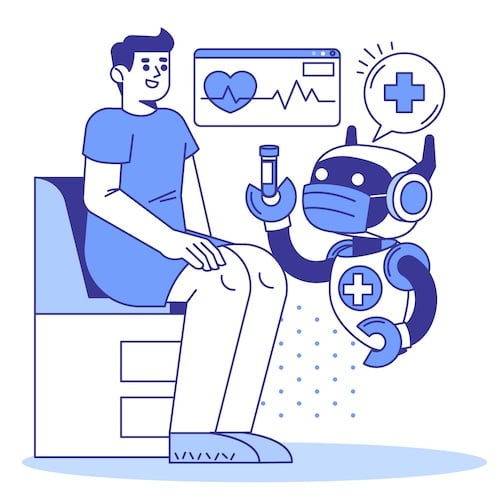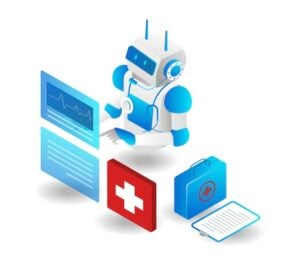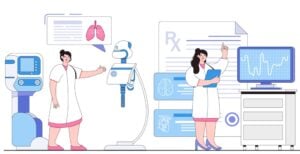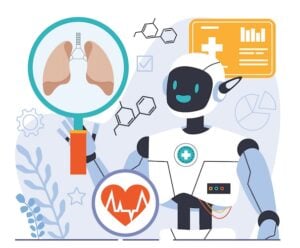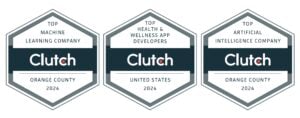Here’s the hard truth: if you’re not leveraging AI for healthcare workflow automation, you’re falling behind. A 2023 Healthcare IT Leaders survey reveals that over one-third of healthcare organizations have begun integrating AI solutions, with an additional 25% running AI pilot programs. This isn’t just a trend—it’s a seismic shift.
We’re talking about transforming how hospitals operate, reducing employee burnout, and slashing healthcare costs. Picture seamless data integration, accelerated staff onboarding, and robust cybersecurity seamlessly woven into your daily operations.
Failing to jump on this AI bandwagon means watching from the sidelines as other organizations boost their patient satisfaction and operational efficiency. Are you really willing to let that happen?
Let’s dive into how you can elevate your healthcare processes and stay ahead in the AI power game.
Top Takeaways:
- Hospital workflow automation is not just a buzzword; it’s revolutionizing healthcare. With over one-third of organizations already integrating AI solutions, it’s become indispensable for reducing burnout, cutting costs, and boosting patient satisfaction.
- Facing challenges like data integration, staff onboarding, and cybersecurity? Workflow automation in healthcare tackles these head-on. It’s your ticket to staying competitive and efficient in today’s fast-paced healthcare environment.
- Implementing automated clinical workflows isn’t optional if you aim for excellence. It significantly enhances patient care, operational efficiency, and financial performance. Success is measured through heightened patient satisfaction, streamlined operations, and an improved bottom line.
Table of Contents:
- The Critical Role of Workflow Automation in Modern Healthcare
- Key Drivers for Healthcare Workflow Automation
- High-Impact Areas for Clinical Workflow Automation
- Real-World Success Stories: Transforming Healthcare with Automation
- Overcoming AI/ML Implementation Challenges
- Measuring Success: KPIs for Healthcare Workflow Automation
- Future Trends and Opportunities in Clinical Workflow Automation
- Why Choose Topflight as Your Healthcare Workflow Automation Partner
The Critical Role of Workflow Automation in Modern Healthcare
Healthcare providers are grappling with an array of formidable challenges—employee burnout, rising operational costs, and half-baked IT implementations that seldom deliver on their promises. This is where healthcare workflow automation steps in as a game-changer.
What is Workflow Automation in Healthcare?
So, what is workflow automation for healthcare? In essence, it involves leveraging technology to automate repetitive tasks, streamline clinical processes, and elevate the overall quality of patient care.
Current Challenges in the Healthcare Industry
Employee Burnout
One of the most pervasive issues in the healthcare sector today is employee burnout. A systematic review found that nearly half of healthcare providers may have burnout symptoms at any given time. This not only affects the well-being of the staff but also compromises patient care quality.
Rising Healthcare Costs
Another pressing concern is the skyrocketing cost of healthcare. Administrative expenses, billing errors, and inefficient processes pile up, driving costs through the roof. Brace yourselves: U.S. healthcare spending is projected to climb by an average of 5.8% in 2024. And patients are increasingly footing more of the bill themselves.
Ineffective IT Implementations
The implementation of IT solutions often falls short of expectations. Many healthcare providers invest heavily in technology, only to find that it fails to integrate seamlessly with existing systems or meet the needs of end-users.
Data Integration and Security
Data integration and cybersecurity remain thorny issues. The healthcare sector is notorious for its fragmented data systems, where patient information is often scattered across multiple platforms. This fragmentation not only hampers operational efficiency but also poses significant risks to data security.
Efficient medical device integration is essential for creating interconnected systems that enhance clinical workflow automation.
Accelerated Staff Onboarding
Onboarding new staff is another area rife with inefficiencies. Traditional onboarding processes are time-consuming and often fail to equip new hires with the tools and knowledge they need to hit the ground running.
Patient Care Quality
Ultimately, all these challenges converge on the most critical aspect of healthcare—patient care. Delays, errors, and inefficiencies directly impact patient outcomes and satisfaction. A streamlined workflow can significantly improve both, bringing us back to the central question: what is workflow automation for healthcare?
The Promise of Workflow Automation
Leveraging workflow automation presents an opportunity to address these challenges head-on. By automating repetitive healthcare administration tasks, healthcare providers can free up valuable time for their staff, allowing them to focus on what truly matters—caring for patients.
Improved data integration ensures that medical histories, lab results, and treatment plans are readily accessible, enabling better-informed clinical decisions. Enhanced cybersecurity measures protect sensitive patient data, mitigating the risk of breaches.
Healthcare workflow automation isn’t just a trend; it’s a necessity for any institution looking to thrive in today’s competitive and regulated environment. It promises not just to alleviate existing pain points but to fundamentally transform how healthcare providers operate, making the system more efficient, secure, and, most importantly, patient-centric.
Key Drivers for Healthcare Workflow Automation
So, why do so many healthcare CIOs and VPs of Technology obsess over healthcare workflow automation?
The answer lies in the multitude of benefits that this strategic move brings to the table. From improving patient care quality to addressing staff shortages and burnout, enhancing operational efficiency, and meeting regulatory requirements, clinical workflow automation is no longer a luxury—it’s an imperative.
A recent survey by Becker’s Healthcare revealed that approximately 30% of hospitals, health systems, and transplant centers currently use clinical workflow automation, with this number expected to reach 61% by 2024. This rapid adoption highlights the growing recognition of automation’s value in healthcare settings. And its implementation is driven by four key factors:
Patient Care Enhancement
Automation streamlines operations that directly impact patient experiences. Electronic health records (EHR) integration enables instant access to comprehensive patient histories, facilitating more accurate diagnoses and effective treatments. For example, integrating EHR PointClickCare with clinical workflow automation can significantly reduce redundancies and improve data accuracy across healthcare systems.
Staff Burnout Mitigation
By automating routine tasks like appointment scheduling and parts of clinical documentation, healthcare workflow automation allows staff to focus on meaningful patient interactions. This redistribution of workload not only improves job satisfaction but also helps retain skilled professionals.
Operational Efficiency and Cost Reduction
Automated processes, such as billing and supply chain management, minimize errors and reduce wastage. This optimization leads to improved financial health for healthcare organizations, allowing them to allocate resources more effectively.
Regulatory Compliance and Data Security
Automated systems ensure secure handling, storage, and transmission of patient data, minimizing the risk of HIPAA violations. Built-in cybersecurity measures protect electronic health information from breaches, while automated compliance monitoring tools continuously scan for potential issues.
High-Impact Areas for Clinical Workflow Automation
If you’ve made it this far, it’s clear you’re serious about leveraging workflow automation in healthcare. Let’s dive into the high-impact areas of health information technology where automation can significantly streamline operations and improve outcomes.
Patient Intake and Scheduling Optimization
- Automated scheduling systems: Allow patients to book and reschedule appointments online.
- Reduced wait times: Improves patient satisfaction.
- Streamlined intake: Minimizes manual errors and frees up staff for critical tasks.
Electronic Health Records (EHR) Integration and Management
- Seamless EHR integration: Real-time access to patient information.
- Automated updates: Lab results and alerts instantly update in EHR.
- Improved diagnosis and treatment: Faster, more accurate clinical decisions.
Considering the cost of EHR implementation is essential for budgeting and planning when automating clinical workflows to ensure a sustainable investment.
Clinical Decision Support Systems (CDSS)
- Real-time recommendations: Automated CDSS provides up-to-date health information.
- Enhanced patient safety: Flags potential drug interactions based on EHR data.
- Informed decision-making: Clinicians have the most accurate information available. Predictive analytics for resource allocation and optimal patient flow.
Effective clinical decision support system implementation can greatly enhance clinical workflow automation by providing real-time insights that aid in decision-making.
Telemedicine and Remote Patient Monitoring
- Telemedicine platforms: Automate appointment bookings and preliminary assessments.
- Billing and insurance: Automated handling of claims.
- Remote monitoring: Continuous data transmission and proactive intervention.
Incorporating wearable technology in healthcare can provide continuous patient monitoring, seamlessly feeding data into automated clinical workflows.
Check out our online doctor app guide to explore top platforms revolutionizing virtual consultations.
Revenue Cycle Management and Billing Automation
- Automated billing systems: Verify insurance, accurately code procedures, submit claims.
- Faster reimbursement: Reduces errors and improves financial health.
- Efficient revenue cycle: Minimizes claim denials and financial strain.
In addition, utilizing advanced clinical trial management software can streamline clinical workflows, ensuring trials are executed efficiently and effectively.
In summary, these high-impact areas show how workflow automation in healthcare can transform clinical processes, enhance operational efficiency, and improve patient care. Ready to hear some real-world success stories? Stick around as we delve into case studies showcasing the transformative power of healthcare workflow automation.
Read more on medical device clinical trials
Real-World Success Stories: Workflow Automation in Healthcare
Workflow automation for healthcare is revolutionizing hospital workflows across various departments. Let’s explore two real-world examples that demonstrate the transformative power of automation in healthcare settings.
Case Study 1: Reducing Patient Wait Times and Improving Satisfaction with Allheartz
Allheartz, a cutting-edge Remote Therapeutic Monitoring (RTM) platform, showcases how workflow automation for healthcare can significantly improve patient experiences and clinical outcomes. By leveraging AI and computer vision technology, Allheartz has transformed physiotherapy and sports care processes:
- Reduced in-person patient visits by up to 50%
- Decreased time spent on clerical work by up to 80%
- Achieved up to 70% injury reduction for athletes undergoing AI-guided exams
The platform’s At-Home Exam Studio (purely an AI-enabled smartphone app) allows patients to perform self-assessments using AI-guided video recognition. This automation of the examination process not only saves time but also provides doctors with more accurate and frequent data points for analysis.
Key features:
- AI-powered pose detection and analysis
- Automated goniometric data extraction
- Seamless integration with existing hospital workflows
The implementation of Allheartz demonstrates how workflow automation can simultaneously improve patient care, reduce administrative burden, and enhance treatment outcomes.
Case Study 2: Streamlining Staff Efficiency with Medical Coding Automation
GaleAI’s revolutionary medical coding automation platform illustrates how AI can transform one of healthcare’s most time-consuming and error-prone processes. By automating the conversion of medical notes to billing codes, GaleAI has achieved remarkable results:
- Identified an estimated $1.14M in yearly lost revenue due to undercoding
- Detected a 7.9% undercoding rate missed by human coders
- Achieved these results at less than 1% of the gained revenue cost
The platform’s key features include:
- Automated coding of operative notes within seconds
- Customization to individual doctor and coder habits
- Seamless EHR integration
GaleAI’s success demonstrates how workflow automation for healthcare can not only improve efficiency but also significantly impact a healthcare organization’s bottom line.
Read more on how to automate clinical notes.
To maximize interoperability, it’s important to integrate health apps with Epic EHR, ensuring seamless data flow and workflow efficiency.
These success stories underscore the transformative potential of workflow automation for healthcare. By streamlining hospital workflows, healthcare organizations can significantly improve patient care, operational efficiency, and financial performance.
As these examples demonstrate, the right automation solution can address multiple pain points simultaneously, from reducing wait times and improving treatment outcomes to enhancing data security and boosting revenue.
A well-executed EHR data migration plan is crucial for maintaining data integrity during the transition to an automated workflow system.
Overcoming AI/ML Implementation Challenges
So, you’re sold on the idea of workflow automation in healthcare—great! But let’s not kid ourselves; implementing such transformative changes is no walk in the park. Here’s a candid look at the hurdles you might face and some practical advice on how to overcome them. Spoiler alert: it’s doable, but it takes effort.
Addressing Budget Constraints and ROI Concerns
One of the first roadblocks you’ll hit is budget constraints. Ironically, the very solution that promises cost savings requires upfront investment. The good news? The ROI on automating clinical workflows is substantial if done right.
Practical Advice:
- Start Small: Begin with pilot projects in high-impact areas like patient intake or billing automation to demonstrate quick wins.
- ROI Analysis: Conduct a detailed ROI analysis to quantify potential savings and efficiency gains. Use these figures to make a compelling case to stakeholders.
- Leverage Grants and Incentives: Look for grants and incentives aimed at healthcare IT improvements. These can offset initial costs.
Navigating Legal and Regulatory Hurdles
The legal landscape in healthcare is a minefield. From HIPAA compliance to state-specific regulations, there’s a lot to navigate. Implementing workflow management solutions that don’t meet these standards is not just risky—it’s potentially disastrous.
Practical Advice:
- Consult Legal Experts: Engage with legal advisors who specialize in healthcare regulations to ensure your solutions are compliant from the get-go.
- Choose Compliant Vendors: Work with vendors who have a proven track record in healthcare and offer solutions that are already compliant with key regulations.
- Regular Audits: Conduct regular audits to ensure ongoing compliance, as regulations can and do change.
Strategies for Successful Change Management and Staff Adoption
Here’s the thing about humans: we’re creatures of habit. Any significant change, even one aimed at making life easier, can be met with resistance. Effective change management is crucial for successful implementation.
Practical Advice:
- Engage Early and Often: Involve key stakeholders and end-users in the planning and decision-making process. Their buy-in is essential.
- Training Programs: Develop comprehensive training programs to get staff up to speed quickly. Use role-based training tailored to specific job functions.
- Communicate Benefits: Clearly communicate the benefits of workflow automation. Highlight how it will reduce workload and make their jobs easier.
- Pilot Programs: Start with small-scale pilot programs to work out the kinks and build user confidence before full-scale deployment.
Hands down, it isn’t a plug-and-play endeavor when you try to automate clinical workflows. This requires careful planning, stakeholder engagement, and a keen eye on regulatory compliance. But the payoff—enhanced efficiency, better patient care, and significant cost savings—is well worth the effort.
Understanding the steps to build a healthcare app is fundamental for organizations looking to develop solutions that enhance workflow automation.
Measuring Success: KPIs for Healthcare Workflow Automation
Alright, so you’ve taken the plunge and invested in automating clinical workflows. Kudos to you! But how do you measure success? What KPIs will tell you it’s working? We’ll break it down into three core areas: patient satisfaction, operational efficiency, and financial performance.
Patient Satisfaction and Outcomes Metrics
Let’s start with the ultimate goal—patient care. When you automate clinical workflows, the impact on patient satisfaction should be evident. Here are the key metrics to watch:
- Patient Satisfaction Scores: Use surveys like HCAHPS (Hospital Consumer Assessment of Healthcare Providers and Systems) to measure patient perceptions.
- Average Length of Hospital Stay: A shorter stay often indicates efficient care and quicker recovery times, thanks to streamlined processes.
- Readmission Rates: Lower readmission rates can signal that patients are receiving appropriate, effective care the first time around.
- Patient Complaints and Compliments: Track these closely to gauge immediate feedback on the changes you’ve implemented.
According to the Future Health Index 2024 report, the trend of using automation to relieve administrative burdens in healthcare is on the rise. More than half of healthcare leaders have implemented automation in key areas such as billing processes (55%), appointment scheduling (59%), patient check-in (54%), and clinical data entry (53%).
All of these measures contribute significantly to better patient satisfaction by streamlining operations and allowing healthcare professionals to focus more on patient care rather than administrative tasks.
Operational Efficiency Indicators
Next up is operational efficiency. If your staff is spending less time on administrative tasks and more time on patient care, you’re on the right track.
- Staff Productivity: Measure the time saved on routine tasks like scheduling, documentation, and billing.
- Turnaround Time for Lab Results: Faster lab result processing means quicker diagnosis and treatment decisions.
- Resource Utilization: Track how efficiently you’re using resources, including staff, equipment, and facilities.
- Error Rates: Lower error rates in medical records, billing, and other areas signify a successful implementation of process improvement strategies.
According to the Future Health Index 2024 report by Philips, a striking 89% of healthcare leaders believe that workflow automation will enable healthcare professionals to operate at their peak performance.
Financial Performance Measures
Finally, let’s talk dollars and cents. ROI is crucial, especially when justifying the investment to stakeholders.
- Revenue Cycle Efficiency: Automated billing and claims processing should translate into faster reimbursements and fewer denied claims.
- Cost per Patient Visit: A reduction here indicates that processes are streamlined, leading to cost savings without compromising care quality.
- Operational Costs: Keep an eye on overall operational expenses. Savings from automation should start to reflect within a few months of implementation.
- Profit Margins: Improved efficiency and reduced costs should positively affect your bottom line.
According to a McKinsey report, AI could automate up to 45% of administrative tasks, potentially saving $150 billion annually.
Of course, measuring the success of automated clinical workflows isn’t just about ticking boxes; it’s about real-world impact. Whether it’s happier patients, more efficient operations, or a healthier bottom line, the proof is in the numbers.
And here’s the kicker: the journey doesn’t end with implementation. Continuous monitoring and process improvement are key to sustaining and enhancing these benefits over time.
Read more on healthcare automation RCM to explore how continuous optimization can transform your revenue cycle management.
Future Trends and Opportunities in Clinical Workflow Automation
Let’s dive into the future of clinical workflow automation. Spoiler alert: it’s filled with groundbreaking changes that can revolutionize healthcare.
AI and Machine Learning
Not just any AI—generative AI is set to transform healthcare. Imagine AI that not only predicts patient outcomes but also generates personalized treatment plans and medical insights based on a vast array of data. This isn’t just about efficiency; it’s about delivering care that’s both precise and proactive.
The adoption of conversational AI in healthcare can further automate routine tasks, freeing up valuable time for medical professionals to focus on patient care.
Blockchain Technology
Beyond the hype, blockchain offers secure, transparent data storage and sharing, streamlining health insurance claims and protecting patient records.
Internet of Medical Things (IoMT)
Connected devices will provide real-time monitoring and data collection, enhancing patient care and accelerating decision-making.
Robotic Process Automation (RPA)
RPA can take over repetitive tasks like scheduling and billing, allowing healthcare staff to focus more on patient care.
Telehealth and Remote Monitoring
Telehealth continues to break geographical barriers, making healthcare more accessible than ever. Implementing chatbots in healthcare within telemedicine and RPM can improve patient engagement and streamline administrative workflows, reducing the burden on healthcare staff.
Why Choose Topflight as Your Healthcare Workflow Automation Partner
When it comes to healthcare workflow automation, you need a partner who understands the complexities and challenges of the industry inside out. That’s where we come in. At Topflight, our expertise spans cutting-edge technologies like computer vision, NLP, and generative AI. We don’t just jump on the latest tech bandwagon; we meticulously craft solutions that fit your unique needs.
Our experience speaks volumes. Take, for instance, our work with generative AI to streamline clinical documentation and predictive analytics. These aren’t just buzzwords—they translate into real, high-quality outcomes, reducing manual workload and improving patient care. We’ve tackled everything from employee burnout to inefficient IT implementations, delivering custom solutions that integrate seamlessly with existing systems.
But we don’t stop at implementation. Our ongoing support ensures that your systems evolve with the times, continuously optimizing to meet new challenges. We’re committed to your long-term success, providing continuous monitoring and innovation to keep you ahead of the curve.
Ready to take the plunge into hospital workflow automation? Let’s transform your operations and elevate patient care to new heights. Schedule a call with us today, and let’s get started on building a more efficient, effective, and patient-centric future.
[This blog was originally published on 9/23/2024 but has been updated for more recent data]
Frequently Asked Questions
How does clinical workflow automation software integrate with existing hospital systems?
We integrate automation solutions with healthcare software seamlessly by using APIs by Mirth and other open-source or commercial providers and HL7 standards, ensuring compatibility with various EHRs and other hospital systems without disrupting current operations.
What specific technologies do you utilize to enhance security and confidentiality of patient data in your automation solutions?
We employ advanced encryption, blockchain technology, and robust access controls to protect patient data, ensuring high-level security and confidentiality.
Can you describe how automation software improves clinical outcomes in previous implementations?
Our software has reduced patient wait times, improved accuracy in diagnostics, significantly boosted medcal coding, and enhanced overall patient satisfaction by streamlining processes and enabling timely decision-making.
Are customization options available to tailor automation software to specific clinical workflows?
We offer extensive customization, including modular components that can be tailored to unique processes, interfaces adaptable to different user needs, and flexible integration capabilities.
How do you ensure compliance with healthcare regulations like HIPAA or GDPR in your workflow automation software?
We strictly adhere to HIPAA and GDPR guidelines, incorporating compliance checks, regular audits, and secure data handling practices throughout our software development and deployment processes.
